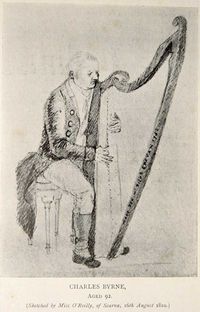Annotation:James Plunkett: Difference between revisions
No edit summary |
No edit summary |
||
| Line 5: | Line 5: | ||
<br> | <br> | ||
<br> | <br> | ||
Little is known about James Plunkett, although Hardiman says that he hailed from Bunenedin, County Sligo, an assertion that O'Sullivan finds little evidence for. | Little is known about James Plunkett, although Hardiman says that he hailed from Bunenedin, County Sligo, an assertion that O'Sullivan finds little evidence for. The accompanying picture shows a sketch made of the Irish harper Charles Byrne playing his harp at the O’Reilly residence at Scarva, Co. Down, drawn by Miss O’Reilly in 1810.[1] Charles Byrne, also called “Charley Berreen”, was from Leitrim and is assumed to have been born c.1712.[2] He was the second oldest of the ten Irish harpers who attended the famed Belfast gathering of 1792, and one of only five who had also performed at all three of the Granard Harp Balls (held in 1781, 1782, and 1785).[3] | ||
<br> | <br> | ||
<br> | <br> | ||
</font></p> | </font></p> | ||
<p><font face="garamond, serif" size="4"> | <p><font face="garamond, serif" size="4"> | ||
''Source for notated version'': Edward Bunting manuscripts [O'Sullivan]. | [[File:Charles_byrne_harp.jpg|200px|thumb|left|Charles Byrne]] | ||
''Source for notated version'': Charles Byrne via Edward Bunting manuscripts [O'Sullivan]. | |||
<br> | <br> | ||
<br> | <br> | ||
Revision as of 01:44, 23 January 2015
Back to James Plunkett
JAMES PLUNKETT. AKA and see "Young William Plunkett." Irish, Planxty (3/4 time). G Mixolydian. Standard tuning (fiddle). AB. Composed by blind Irish harper Turlough O'Carolan (1670-1738). Belfast collector Edward Bunting [1] (1773–1843) noted the tune from the playing of harper Charles Byrne at the end of the 18th century. O'Sullivan (1958) says that Bunting's version appears to be the original from which Percy Frency derived the air of his song "Phil the Fluter's Ball." Bunting had several versions of the tune, and printed one version under the erroneous title "Young William Plunkett," according to O'Sullivan, which was then picked up and reprinted by Francis O'Neill.
Little is known about James Plunkett, although Hardiman says that he hailed from Bunenedin, County Sligo, an assertion that O'Sullivan finds little evidence for. The accompanying picture shows a sketch made of the Irish harper Charles Byrne playing his harp at the O’Reilly residence at Scarva, Co. Down, drawn by Miss O’Reilly in 1810.[1] Charles Byrne, also called “Charley Berreen”, was from Leitrim and is assumed to have been born c.1712.[2] He was the second oldest of the ten Irish harpers who attended the famed Belfast gathering of 1792, and one of only five who had also performed at all three of the Granard Harp Balls (held in 1781, 1782, and 1785).[3]

Source for notated version: Charles Byrne via Edward Bunting manuscripts [O'Sullivan].
Printed sources: Complete Collection of Carolan's Irish Tunes, 1984; No. 151, p. 103. O'Neill (Krassen), 1976; p. 233 ("Young William Plunkett"). O'Neill (Music of Ireland: 1850 Melodies), 1903; No. 650, p. 117 (as "Young William Plunkett"). O'Sullivan (Carolan: The Life, Times and Music of an Irish Harper), 1958; No. 151, p. 181.
Recorded sources:
